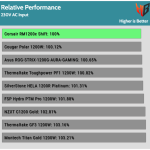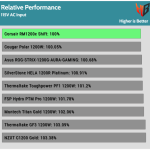Summary and conclusion
The competition is tough and the last place in this table does not flatter Corsair’s new high-performance power supply at first glance, of course. Nevertheless, the difference to most of the competitors is not big, which puts this positioning into perspective. The Thermaltake GF3 1200 and the NZXT C1200 lead the race, but the gaps are really rather marginal:
And what else? The RMx 1200 and 1000 Shift models use a larger circuit board than the 850W and 750W models, which allows for good airflow. The large perforations of the fan grille also contribute to this. Overall, all Shift models offer quiet operation under normal operating conditions. Switching to an FDB fan instead of the ML fan that the RMx units use definitely helped. I’m a big fan of ML fans as they can handle high operating temperatures, but it just doesn’t seem that easy to keep them quiet either.
Load regulation is within 1% on all major rails, ripple suppression is decent, transient response is good, and holdup time is longer than required. In addition, the device is ATX v3.0 and PCIe 5.0 ready as it passed all the tough transient response tests with up to 2400W transient loads with flying colors! However, Corsair should still improve the average efficiency and increase the overall performance a bit by further optimizing the platform in some areas. I suspect that the side-mounted modular panel does not make achieving the best possible performance easy.
The key selling points of all RMx Shift cases are the side-mounted modular panels, ATX v3.0 and PCIe 5.0 compatibility, and low noise. These units also feature a high build quality that ensures they will outlast the extended ten-year warranty. Kudos to Corsair for thinking outside the box and offering a power supply with a unique design. Hopefully, case manufacturers will welcome this new power supply design and make their products compatible.
| Per | Contra |
| Full power at 47°C ATX v3.0 and PCie 5.0 capable Unique design (side-mounted modular panel) Cybenetics ratings next to 80 PLUS Sufficiently good transient response Top build quality Properly set OCP and OPP at 12V Quiet operation High efficiency at light load Long hold-up time Low inrush current at 115 V ALPM support Numerous connectors, including a 600W 12VHPWR Fully modular Low power dissipation |
The overall performance can’t quite keep up with the competition The average efficiency could be improved The 5VSB rail could be more efficient Not so tight load regulation at 3.3V The short distance between all peripheral connections |
Many thanks to Aris, whose data I am allowed to use in the future and will do so, if readers want such network tests. Today’s article is once again a gauge of whether this topic resonates with you. And I also specifically chose this power supply this time because I had it myself in practical use with an NVIDIA RTX 4090 FE cranked up to 600 watts. From this point of view, the price of 150 Euros on average is really okay.
- 1 - Einführung, technische Daten und Testreport
- 2 - Unboxing, Kabel und Schutzschaltungen
- 3 - Teardown: Topologie, Komponenten, Verarbeitung
- 4 - Load Regulation, Ripple Suppression, Transient Resonse
- 5 - Hold-Up Time, Timings, Inrush-Current
- 6 - Average Efficiency and PF
- 7 - Betriebsgeräusch und Lüfter
- 8 - Zusammenfassung und Fazit




































27 Antworten
Kommentar
Lade neue Kommentare
Urgestein
Mitglied
Veteran
Urgestein
1
Moderator
1
Urgestein
Urgestein
1
Mitglied
Mitglied
Urgestein
Urgestein
Urgestein
Urgestein
Veteran
Urgestein
Urgestein
Alle Kommentare lesen unter igor´sLAB Community →